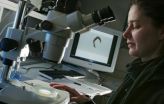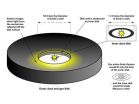The results of this study indicated that ballet dancers were significantly less likely to be able to return to work compared with modern dancers or dance theater performers. Older age and having a variety of hip abnormalities also influenced outcome. "This data is helpful to patients trying to reach a decision regarding surgery. We now have information on the time frame for recovery as well as the likelihood of being able to return to dance," said Douglas Padgett, M.D., chief of Adult Reconstruction and Joint Replacement at Hospital for Special Surgery, who led the study.
Professional dancing is a particularly physically demanding occupation with annual injury rates of 67% to 95%, with over 20% of these being hip injuries. "Hip injury is very common in professional dancers. Many of these individuals tend to be hyper mobile. They are performing very rapid loading and landing activities and an extreme range of motions," said Dr. Padgett. Treatment can range from physical therapy to arthroscopic or open surgery.
HSS launched the study because there was no data available to help counsel professional dancers about their chances of returning to work after hip arthroscopy. The retrospective study looked at 40 professional dancers who had hip arthroscopy conducted by a single surgeon at Hospital for Special Surgery. One patient had hip arthroscopy in both hips and all others had only one hip operated on. Of the 31 female and nine male dancers, 15 were ballet dancers, 14 were involved in musical theater, and 11 were modern dancers. The average follow-up was 29.8 months.
The primary outcome was return to professional dance for at least three months, and the study found that the majority of dancers, 73% (29), were able to do this. The average return to work was 7.4 months. Younger age was a predictor of success. The average age of dancers who returned to work was 30.4 compared with 39.7 in those who did not return. Of the three types of dance, ballet dancers were less likely to return to their career—with only 60% returning to work. This is in comparison to 73% of modern dancers and 79% of dancers in musical theater. Ballet dance tends to involve the need for greater range of motion and holding the leg in more extreme positions which appears to be more difficult during the recovery phase, according to Dr. Padgett.
Other factors also influenced outcome. Dancers who returned to work had less degeneration of the articular cartilage of the hip joint as determined by high resolution MRI. Patients with normal radiographs (89%) and Cam impingement (70%) had higher return to work than those with hip dysplasia (64%). Cam type impingement describes a bump on the surface of the ball (femoral head) that jams on the rim of the socket. Hip dysplasia is a condition where the cavity in the pelvic bone that forms the hip socket has limited coverage of the head of the femur, the round ball that fits inside the socket. To compensate for this loss of coverage, the labrum (a type of fibrocartilage) becomes hypertrophied and is at risk for tearing.
Dr. Padgett said that identification of factors linked to better outcomes should help doctors with their ability to counsel patients. "You can tell the patient, you have this problem, you have a labral tear and some morphological abnormality in the shape of your hip joint and if you have an operation, you stand a 75% chance of getting back and continuing to dance," Dr. Padgett said. "But factors like a little bit of early arthritis, being over the age of 35, you have this hip dysplasia and you are a ballerina—this is a less favorable situation for full return to work. So, if I have that person come into my office, I don't say, 'you have a 75% of chance to get back to dance.' That number in their case may be down to fifty-fifty, and with that information we can discuss the pros and cons of surgery versus some nonoperative approach."
Armed with this information, a dancer may decide to perhaps just finish up the season and call it a career. "Professional dancers at 35 are relatively rare because at that point, their body just can't take it anymore. It's really brutal on your body."
Also useful for doctors is the information gathered from the study during the preoperative diagnoses that showed that 54% of patients had hip dysplasia and 24% had Cam impingement. "This type of information is good for both the patient and the physician. It is good for the physician to be on the lookout for these types of injuries in people who are in the performing arts. To simply attribute vague hip pain to 'oh, you pulled a hip muscle' is probably not appropriate," Dr. Padgett said. "In 2011, if you have somebody who has pretty significant hip pain and the X-rays are somewhat unremarkable, the next step would be to get an MRI."
###
Other Hospital for Special Surgery investigators involved in the study include Haydee Brown, M.D., Sommer Hammoud, M.D., and Bryan Kelly, M.D.
Hip Arthroscopy in the Professional Dancer (Paper 642)
Friday, Feb. 18, 11:54 a.m. – 12:00 p.m. San Diego Convention Center, Room 7.
About Hospital for Special Surgery
Founded in 1863, Hospital for Special Surgery (HSS) is a world leader in orthopedics, rheumatology and rehabilitation. HSS is nationally ranked No. 1 in orthopedics, No. 3 in rheumatology, No. 16 in neurology and No. 18 in geriatrics by U.S. News & World Report (2010-11), has received Magnet Recognition for Excellence in Nursing Service from the American Nurses Credentialing Center, and has one of the lowest infection rates in the country. From 2007 to 2011, HSS has been a recipient of the HealthGrades Joint Replacement Excellence Award. A member of the NewYork-Presbyterian Healthcare System and an affiliate of Weill Cornell Medical College, HSS provides orthopedic and rheumatologic patient care at New York-Presbyterian Hospital at New York Weill Cornell Medical Center. All Hospital for Special Surgery medical staff are on the faculty of Weill Cornell Medical College. The hospital's research division is internationally recognized as a leader in the investigation of musculoskeletal and autoimmune diseases. Hospital for Special Surgery is located in New York City and online at www.hss.edu.
For more information contact:
Phyllis Fisher
212-606-1197
FisherP@hss.edu
Tracy Hickenbottom
212-606-1197
HickenbottomT@hss.edu
END


